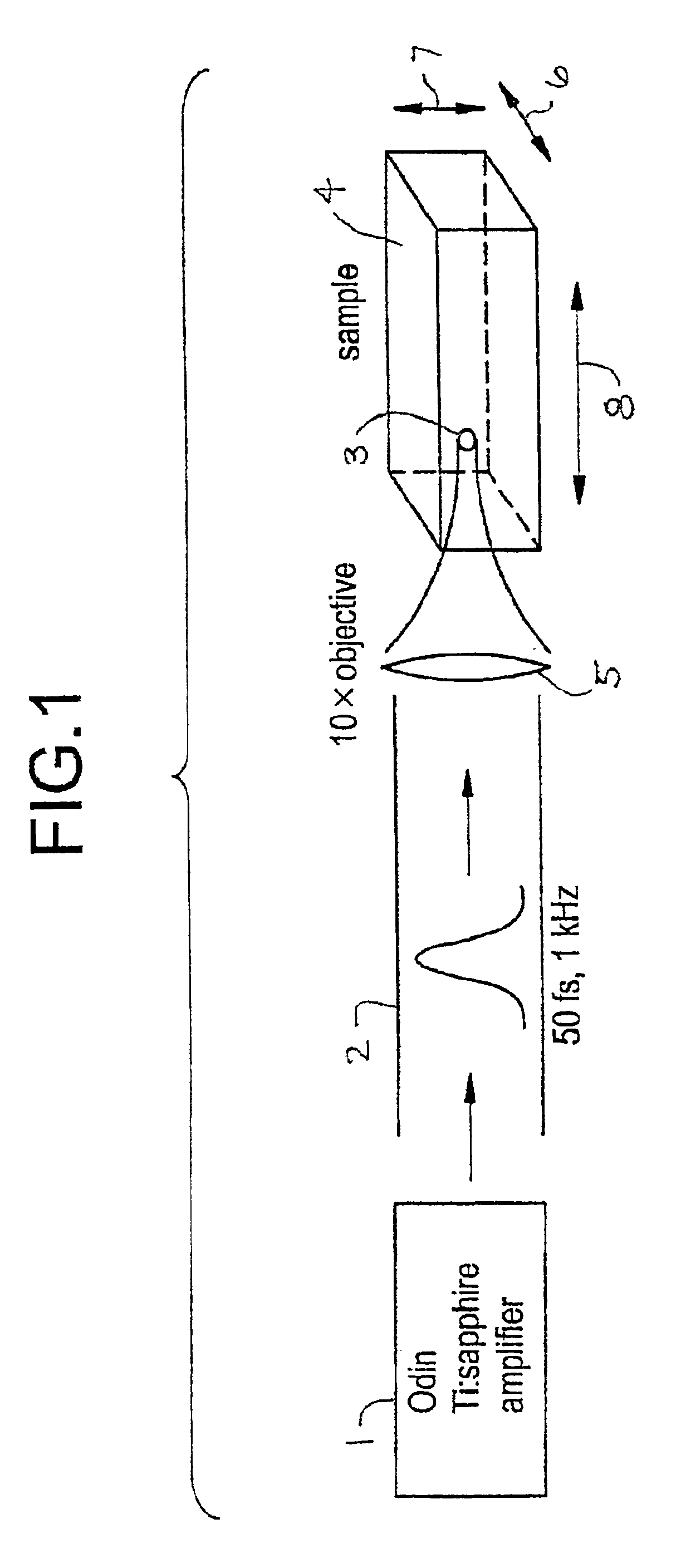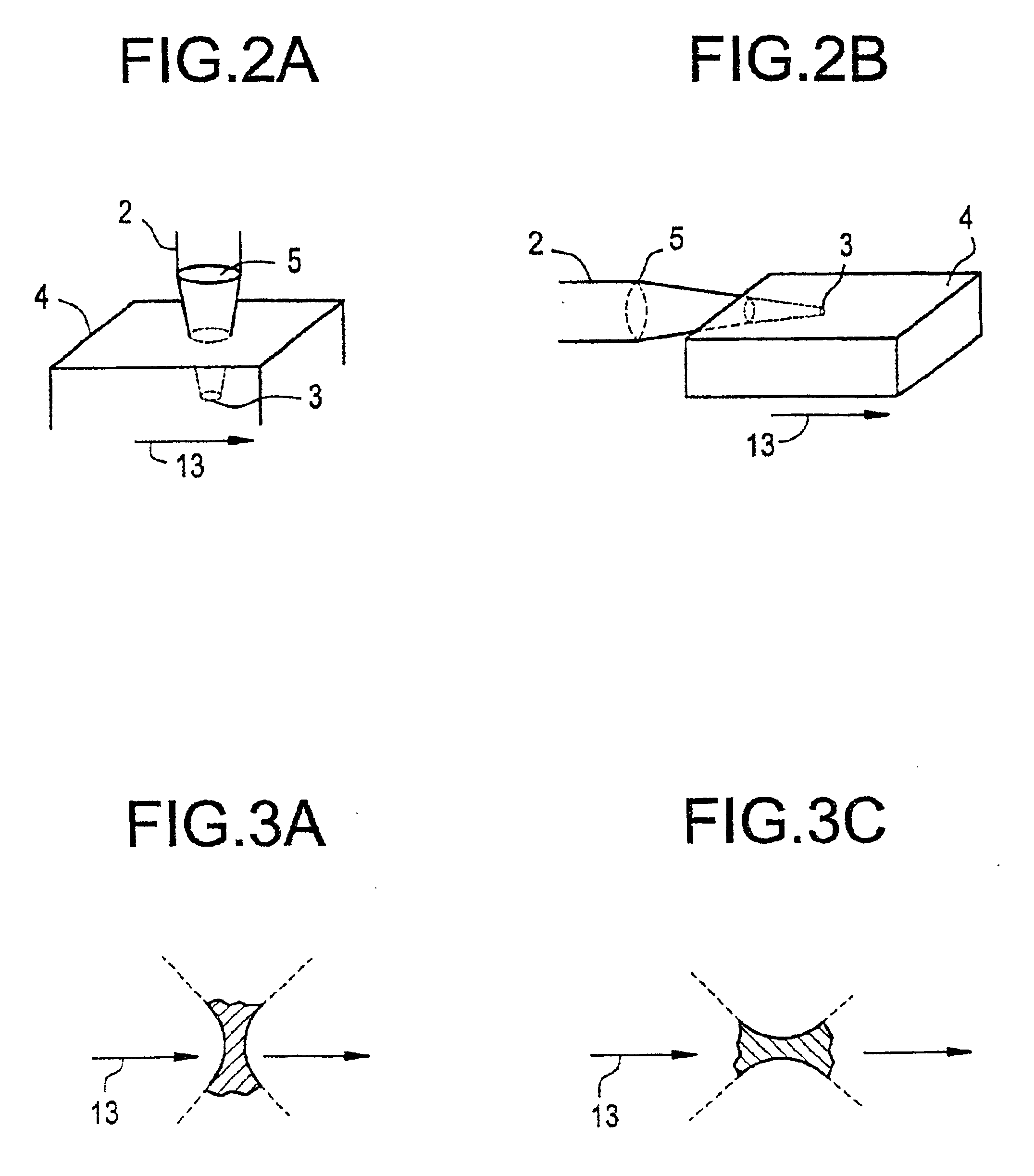Direct writing of optical devices in silica-based glass using femtosecond pulse lasers
a technology of optical devices and pulse lasers, which is applied in the direction of photomechanical equipment, instruments, manufacturing tools, etc., can solve the problems of detracting from the waveguide properties of glass, increasing pulse energy, and physical damage to glass, so as to maximize the writing rate, maximize the exposure intensity, and increase the repetition rate preferably
- Summary
- Abstract
- Description
- Claims
- Application Information
AI Technical Summary
Benefits of technology
Problems solved by technology
Method used
Image
Examples
example 1
[0066]Pulses from a Ti:Sapphire multi-pass amplifier which were 60-fs in duration and had pulse energies of approximately 1 μJ were focused with a 10× (0.16 NA) microscope objective into fused-silica glass samples mounted on a computer-controlled high-precision 3-D translation stage. The fused-silica samples were translated through the focal point of the beam at a rate of 30 μm / s. Waveguide structures were created within the bulk material.
example 2
[0067]A 830 nm laser was used to deliver 40 fs pulses at a 1 kHz repetition rate. The energy per pulse was from about 1 μJ to about 5 μJ. The beam was focused into the glass below the surface with a lens having a numerical aperture of 0.16 in air. The sample was moved under the beam at a rate of about 5 μm / s to about 100 μm / s. The experimental conditions were kept constant for exposure to samples of fused silica and for 14 wt. % GeO2-86 wt. % SiO2. The beam was focused about 1 mm below the surface of the glass. For samples irradiated at the same exposure conditions, the diameter of the laser-affected region of the germania-silica sample was about twice that of the fused-silica sample. From this result, we concluded that the germania-silica material was more sensitive to refractive index changes induced by ultra-fast laser exposure than fused silica.
example 3
[0068]Substrates of various glass compositions, i.e., SiO2 (Corning product 7980), 22 wt. % GeO2-78 wt. % SiO2, and 9 wt. % B2O3-91 wt. % SiO2, were exposed to focused laser radiation by the axial-write method. The laser wavelength was 830 nm. The pulse duration was 40 fs. The energy per pulse was 1.0 μJ. The repetition rate was 1 kHz. The scan speed was 20 μm / s. After exposure, the induced refractive index change at 633 nm was estimated from the far-field pattern of the waveguide produced. The induced refractive index change results are tabulated below in Table 1. The annealing point of each of these materials is also reported in Table 1.
[0069]
TABLE 1Induced refraction index change (Example 3)Glass Composition(% based onAnnealing PointInduced Refractiveweight)(° K)Index ChangeSiO2 (Corning 7980)1261-13230.000378% SiO2 - 22% GeO213110.000991% SiO2 - 9% B2O310730.0030
PUM
| Property | Measurement | Unit |
|---|---|---|
| wavelength | aaaaa | aaaaa |
| absorption edge | aaaaa | aaaaa |
| power | aaaaa | aaaaa |
Abstract
Description
Claims
Application Information
 Login to View More
Login to View More - R&D
- Intellectual Property
- Life Sciences
- Materials
- Tech Scout
- Unparalleled Data Quality
- Higher Quality Content
- 60% Fewer Hallucinations
Browse by: Latest US Patents, China's latest patents, Technical Efficacy Thesaurus, Application Domain, Technology Topic, Popular Technical Reports.
© 2025 PatSnap. All rights reserved.Legal|Privacy policy|Modern Slavery Act Transparency Statement|Sitemap|About US| Contact US: help@patsnap.com



